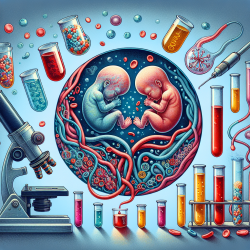Introduction
Twin-to-Twin Transfusion Syndrome (TTTS) is a serious complication in monochorionic twin pregnancies, characterized by an unequal blood supply between the twins. This condition can lead to significant neonatal morbidity and mortality. Recent research has delved into the proteomic differences in amniotic fluid between donor and recipient fetuses in TTTS cases, providing new insights that could enhance diagnostic and therapeutic strategies.
Proteomic Analysis: A New Frontier
The study titled "The Amniotic Fluid Proteome Differs Significantly between Donor and Recipient Fetuses in Pregnancies Complicated by Twin-to-Twin Transfusion Syndrome" utilized advanced proteomic techniques to identify differentially expressed proteins (DEPs) in the amniotic fluid of affected twins. This research highlights the potential of proteomics in understanding the pathophysiological challenges faced by each fetus.
Key Findings
The study identified 103 proteins with significant differences in abundance between donor and recipient fetuses. Notably, proteins upregulated in recipient twins were linked to cardiac and dermatological diseases, often due to volume overload. Conversely, proteins elevated in donor twins were associated with inflammation and ischemic cardiovascular complications.
Implications for Practitioners
For practitioners, these findings underscore the importance of integrating proteomic data into clinical practice. By understanding the specific proteomic profiles of donor and recipient twins, healthcare providers can:
- Enhance diagnostic accuracy through the identification of specific biomarkers associated with TTTS.
- Develop targeted therapeutic interventions aimed at addressing the unique challenges faced by each twin.
- Monitor disease progression and treatment efficacy using proteomic biomarkers.
Encouraging Further Research
While this study provides a foundational understanding of the proteomic landscape in TTTS, further research is necessary to validate these findings and explore their clinical applications. Practitioners are encouraged to collaborate with researchers in the field of proteomics to develop comprehensive biobanks and conduct longitudinal studies that could lead to improved outcomes for affected twins.
Conclusion
The integration of proteomic data into TTTS management represents a promising advancement in fetal medicine. By leveraging these insights, practitioners can enhance diagnostic precision and develop more effective treatment strategies, ultimately improving outcomes for both donor and recipient twins.
To read the original research paper, please follow this link: The Amniotic Fluid Proteome Differs Significantly between Donor and Recipient Fetuses in Pregnancies Complicated by Twin-to-Twin Transfusion Syndrome.










